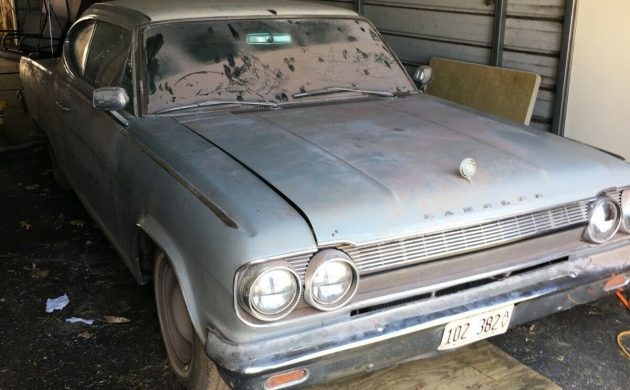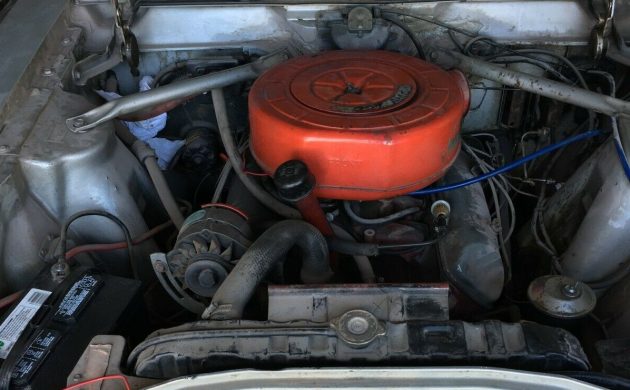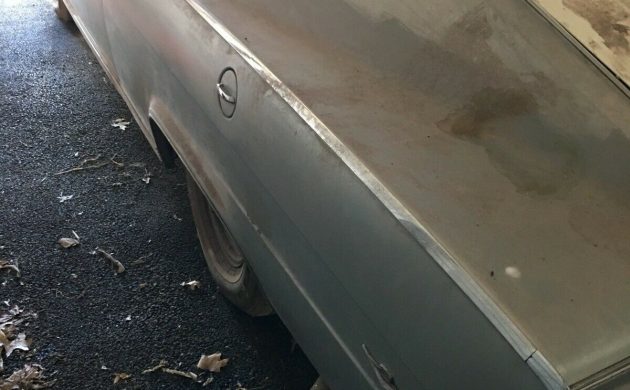The stunning styling and availability of some healthy V8 engine options should have ensured that the Marlin was a sales success. Instead, it lasted for a mere three model years, and AMC managed to sell a paltry 17,419 cars during those years. The end result of this was that the Marlin was discontinued at the end of 1967. Just how long this Marlin has been sitting in a barn isn’t clear, but the time has come for it to leave that barn and head to a new owner. It is located in Danville, Illinois, and is listed for sale here on eBay. For a solid car of this rarity, the BIN price of $5,000 makes it an interesting proposition, so let’s have a bit of a look at the Marlin and see what the next owner would be getting for their money.
The Marlin was descended from the Tarpon concept car, which broke cover at the Society of Automotive Engineers National Convention, on January 17, 1964. AMC had asked Richard A. Teague to produce a concept within the spirit of the pony car theme built on the American chassis, and he really delivered. There were aspects of this concept car that simply weren’t practical for a production car, but work proceeded on transforming a concept into a production car. In a demonstration of sheer determination, the Marlin went from concept to production in just over 1-year. One change which Teague agreed with was enlarging the car to move it from a pony car to an intermediate. Another change was implemented when Teague was not present, and it was a change that he always felt spoiled the styling of the car. The original Tarpon was only 52½” high, some 2″ lower than the average fastback design, so a decision was made to raise the roofline by 1″. This particular Marlin is from the first, and the most successful, year of production, and is finished in Viscount Medium Blue with a Frost White top. The owner refers to the car as being relatively rust-free, but I really am not sure exactly what that means. There are certainly no obvious, visible signs of rust, but it isn’t clear how solid the floors are. One big plus is the fact that the car does appear to be complete. This is good news, as some of the smaller external trim items can be difficult to locate today. This is especially true, as the car carried different branding during each of its 3-years of production. In 1965 it was the Rambler Marlin, in 1966 it was simply the Marlin, while in 1967 it was the AMC Marlin. That means that there are some subtle differences in badges and trim across those years.
The interior of the original Tarpon was extremely luxurious and carried some features that simply weren’t viable options in a production car. Still, AMC aimed to make the interior of the Marlin pretty special, so trim materials were of top quality. This interior will need some restoration work. It isn’t clear whether items such as the door trims are present, or whether they are MIA. I hope that they are still there, as these are another item which can be potentially difficult to locate. The dash and pad look like they are in really good and original condition. The rear seat and headliner also look like they might respond well to a clean, and it is interesting to note that while the car features manual windows, it is fitted with a power driver’s seat.
You would expect that after sitting for a while, the next owner of the Marlin would be facing a mountain of work to revive the car. Well, part of this has already been addressed. The owner has removed the fuel tank and had it cleaned and lined. He has also flushed the fuel system, and the original carburetor, which was deemed to be unfit to rebuild, has been replaced with an Edelbrock. The result is that the original 327ci V8 now starts and runs well. For those who are worried about originality, the owner still retains the original Holley carburetor, and I guess that the next owner can have this assessed to see if it can be rebuilt. The car has also been fitted with new points, plugs, condenser, cap, rotor, and plug wires, so all of this should produce a clean running engine. The master cylinder and booster have also been replaced, but the brakes themselves will need attention. Backing the 327 is the 3-speed automatic transmission, and power steering was also chosen for this car. The Marlin was available with a choice of three different engines, and the split across these in 1965 is quite interesting. There were 2,005 people who chose the 232/6-cylinder, 2,309 who chose the 287/V8, and a whopping 6,013 who handed over their money for the 327/V8. That accounts for the total of 10,327 cars that were sold in 1965, which was also the Marlin’s most successful year. For 1966, the company sold 4,547 cars, while 1967 saw only 2,545 cars roll out of the showrooms. That spelled the end of the Marlin.
The Marlin was a car that deserved to be a success because it was a striking looking car. The sad fact is that it was like so many cars that were produced by AMC: Cars that almost made the grade, but not quite. With only 2,500 cars being produced in the final year of production, it didn’t go out with a bang, but with a whimper. You would think that the rarity of the Marlin would translate into respectable values, but it really hasn’t happened. The most desirable examples are the ones that were optioned with the 327ci engine, so this car ticks that box. If this was a car with the innovative “twin-stick” manual transmission that would make an enormous difference because only around 6% of buyers chose that option. A nice Marlin equipped as this one is can be had for little more than $12,000, while an immaculate one will set you back around $19,000. If this one is solid and relatively rust-free, it might make a viable project car.












WASH THE CAR before posting!!!!!
I have a ’65 Marlin that I’ve owned for about 30 years, V8 with column-shift automatic as seen here. Unfortunately it developed some issues and is currently a stalled project that I just have not been able to get to for quite a while. It’s going to take some time and effort to wake it back up and take care of the mechanical problems that sidelined it to begin with, and to deal with any new ones caused by its long slumber. “Old guy stalled project syndrome” is a real thing, I’m afraid.
I did drive my Marlin for a good long time though and took it on several long-distance trips. These cars are very comfortable cruisers and have plenty of power with the 327 V8, though the relatively inefficient Borg-Warner automatic takes some of the edge off versus a stick shift.
Standard power front disc brakes means a ’65 Marlin stops much better than most cars of that time period. (Discs became optional in ’66 so the price could be lowered a bit.) You can still get parts for the 4-piston Bendix front discs, but the rear “non-servo” drums are another story. You’ll have better luck finding parts for a crashed flying saucer! Best to replace with standard Bendix drums back there and install a proportioning valve. (This is a PITA job due to the AMC’s two-piece axle shaft and hub setup.)
My friend has a nice Marlin, and driving it around he gets endless positive comments and attention, I don’t think a Corvette would generate the same interest.
Nice car. Great price.
Too bad about poor presentation
Potentially good car, price too high because of the poor presentation. Take it out into the sunlight, wash it, clean up the inside a bit, take underside pics and trunk pics. Now, you have earned your money.